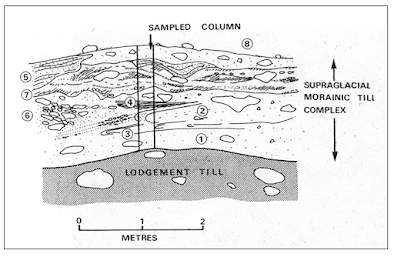This is a huge new report summarising the developments in glacial geomorphology over the past decades. It's written by Dave Evans and Ian Evans from the Durham University Geography Department -- where I was once based. It covers a vast range or territory, with copious references and illustrations.
I won't even attempt to cover the contents, but one thing stands out for me -- and that is the complexity of glacial sediments and landforms associated with different styles of ice wastage. Here is one interesting quote:
Understanding the modification of debris concentrations in glacier ice during melt-out has been critical to predicting the landform and sedimentary products of supraglacial environments. The sedimentary signature, termed melt-out till by Boulton (1970b), was portrayed as a material that could contain a preservation of former englacial debris banding, confirmed by the benchmark study of Lawson (1979a, b, 1981) on stratified basal ice in the Matanuska Glacier, Alaska. From this emerged the notion that it could also accumulate as landforms in a pattern that was dictated by those debris bands. This was encapsulated in the developing ideas on controlled moraines (cf. Gravenor and Kupsch 1959; see D.J.A. Evans 2009a for a discussion), defined more recently by Benn and Evans (1998) as supraglacially deposited hummocky moraine with a clear linearity related to inheritance of debris concentration patterns in the ice.
Although Boulton (1970b) championed the concept of melt-out till, he nevertheless simultaneously emphasized (Boulton 1968, 1971) the fact that debris melting out on a glacier surface was invariably modified into flow till (sensu Hartshorn 1958). Indeed, a number of studies of supraglacial transverse moraines correctly identified their prominence prior to complete melt-out (e.g. Hooke 1970, 1973a, b; Holdsworth 1973; Fitzsimons 1990; Glasser et al. 1998; Hambrey et al. 1999; Ó Cofaigh et al. 1999; St Onge and McMartin 1999; Dyke and Savelle 2000), but none could unequivocally demonstrate a high preservation potential after deglaciation (see Dyke and Evans 2003; Lukas et al.2005; Evans 2009a for a critique). The theory behind this apparent dominance of reworking and lack of in situ, passive melt-out was expounded by Paul and Eyles (1990), who demonstrated that the process of thaw consolidation was capable of preserving englacial structure only if meltwater drainage away from the site was efficient; otherwise elevated porewater pressures decreased the frictional strength of the debris and increased the likelihood of failure and remobilization.
=====================
https://www.lyellcollection.org/doi/full/10.1144/M58-2021-17Glacial processes and landforms
Authors: David J. A. Evans and Ian S. Evans
Volume 58. 10 June 2022
pp 333 - 377
https://doi.org/10.1144/M58-2021-17
Abstract
From 1965 to 2000 glacial geomorphology became increasingly specialized and developed significantly due to technological improvements, particularly in remote sensing, surveying and field-based glaciological process studies. The better understanding of basal thermal regimes in ice sheets and glaciers led to the development of concepts such as spatial and temporal migration of ice divides in dynamic ice sheets that could overprint subglacial landform assemblages, debris entrainment processes related to polythermal glacier systems, and glacier and ice sheet beds composed of cold and warm based mosaics. Process observations at the ice–bed interface led to the discovery of the third glacier flow mechanism, substrate deformation, which provided the impetus to reconstruct the genesis of subglacial bedforms such as drumlins and to evaluate the origins and potential flow law for till. Numerical evaluations of glacial erosion led to a better understanding of abrasion and quarrying as well as the erection of genetic models and erosion rates for larger-scale features such as U-shaped valleys and cirques. Linkages were made between debris transport pathways and moraine construction in supraglacial environments, with the role of glacier structure being linked to specific landforms, such as medial, lateral, hummocky and ice-cored moraines as well as rock glaciers. Our appreciation of the erosional and depositional impacts of glacifluvial systems was enhanced significantly with the advent of process observations on the hydrology of modern glaciers as well as the final vindication of J.H. Bretz and his proposed jökulhlaup origins of the Channelled Scablands and the Missoula Floods. In addition to the increasing numbers of studies at modern glacier snouts, the embracing of sedimentology by glacial geomorphologists was to result in significant developments in understanding the process-form regimes of subglacial, marginal and proglacial landforms, particularly the recognition of landform continua and hybrids. Advances resulting from this included the recognition of different modes of moraine and glacitectonic thrust mass development, lithofacies models of the varied glacifluvial depositional environments, and the initial expansion of work on the sediments and depocentres of glacimarine settings, the latter being the result of glacial research taking to submersibles and ice-strengthened ships for the first time. A similarly new frontier was the expansion of research on the increasingly higher resolution images returning from Mars, where extraterrestrial glaciations were recognized based on comparisons with Earth analogues. Holistic appreciations of glaciation signatures using landform assemblages were developed, initially as process-form models and later as glacial landsystems, providing an ever-expanding set of templates for reconstructing palaeoglaciology in the wide variety of topographic and environmental settings, which also acknowledge spatial and temporal change in glacier and ice sheet systems.


No comments:
Post a Comment